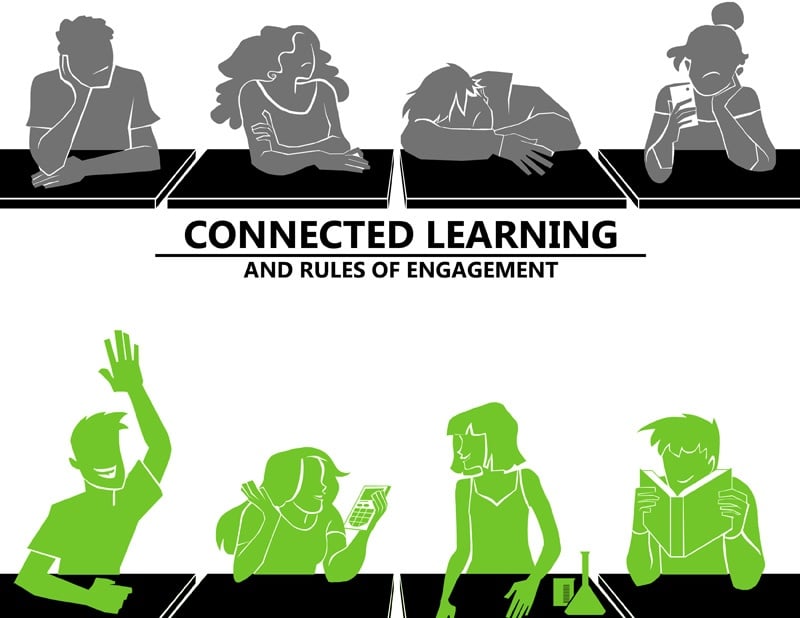In this article, middle school teacher Sam Reed shows how students who act like “they’re too cool for school” can find themselves engaged in learning. Want to share your thoughts on this? Subscribe to the Heinemann Digital Campus and join the discussion. Unlimited access to more articles like this, as well as video clips and full-length books are available on the Heinemann Digital Campus. Subscribe now: http://www.heinemann.com/digitalcampus/referenceLibrary.aspx
In this article, middle school teacher Sam Reed shows how students who act like “they’re too cool for school” can find themselves engaged in learning. Want to share your thoughts on this? Subscribe to the Heinemann Digital Campus and join the discussion. Unlimited access to more articles like this, as well as video clips and full-length books are available on the Heinemann Digital Campus. Subscribe now: http://www.heinemann.com/digitalcampus/referenceLibrary.aspx
Rules for Engagement: Igniting and Challenging Kids’ Creativity and Empathy
Written by Samuel Reed III

During a minilesson I was presenting on the importance of empathy, one of my “too cool for school” girls protested, “Why are you trying to teach us how to get along? What does empathy have to do with learning how to read?” Welcome to the messy and complex world of classroom teaching. Motivating students who view learning as a one-way transaction and school as generally not a fun or generative space is an ongoing challenge.
Scaffolding and Developing Students’ Critical Thinking Skills
The rules for engagement require teachers to ignite students’ natural interests and passions. The hook for many of my struggling and disengaged students is a connection between “curriculum” and their personal lives. When my students began a close reading of The Odyssey, they explored the mortals, immortals, demigods, monsters, and titans of Greek mythology in the context of the exotic locales visited by Odysseus, then used this knowledge to create their own board games based on his travels.
Promoting Creativity and Innovative Thinking Skills
The rules for engagement require that students use their imagination. Albert Einstein said, “Imagination is more important than knowledge.” Therefore, I need to create opportunities for my middle schoolers to play and use their imitative imagination (reconstructing past images or experiences) and their creative imagination (relying on these past images or experiences to construct sensations or conditions never before experienced). When students tinker, try new ideas, and collaborate, they learn more than just content, they produce something of which they can be proud. To sustain my students’ interest in The Odyssey, I designated time both in and after school when they could construct facsimiles of Greek gods and goddesses, weapons, and other elements important to the story. Without prompting, nearly twenty “too school to be cool” kids showed up at the after-school session. A boy in a group of male students who were creating a statue of Athena out of cardboard said, “It’s cool that we get to work on whatever we want to make.” This freedom to “make stuff” is also a cornerstone of highly successful companies like Google.
Building Collaborative Spaces and Cooperative Learning Skills
The rules for engagement presuppose a classroom that promotes risk taking, embraces learning from mistakes, and emphasizes that process is as important as product. Many of my students are not accustomed to an inquiry-infused, collaborative curriculum, and tensions naturally arise. I had my class watch and discuss Steven Johnson’s YouTube video Where Good Ideas Come From:
We learned that effective collaboration requires an appropriate space, adequate time, and empathy.
After we discussed what collaboration looks and sounds like, student working groups, or pods, created their own board game prototypes. Some of their ideas were very creative; I was impressed by their thorough knowledge both of game concepts and the content their games incorporated.
A collaborative classroom does not happen overnight. My students had an “aha” moment during our character study of Odysseus, in which we explored the tragic results of Odysseus’ arrogant and nonempathetic behavior. I was delighted when I overheard the girl who asked the question with which this essay begins tell her fellow pod members, “This is why Mr. Reed was trying to teach us about empathy; look at how Odysseus’ cocky behavior caused problems for his comrades.” Eureka! The realization that individual behavior influences group behavior had major impact on our class dynamics and learning.
Designing Video Games That Include Educational Elements
The rules for engagement require that students be treated as fabricators, designers, and real-world problem solvers. We live in creative economy, and our students will have to be creative problem solvers, know how to collaborate and communicate, in order to compete in the global marketplace. Therefore, it is critical that students share their work and knowledge outside the classroom. After my students designed their own board games and cardboard creations, I had them demonstrate their knowledge of The Odyssey by creating multilevel video games on Gamestar Mechanic’s website. Working in pods of three or four, students brainstormed game concepts, created storyboards and prototypes, and solicited feedback to improve their design ideas. Later, one of the alpha males in the class asked, “How did you know we would like doing this?” He and many other students came to see the value of connected learning, not just learning for learning’s sake. The work we were doing in class was useful outside the classroom.
 About the author:
About the author:


